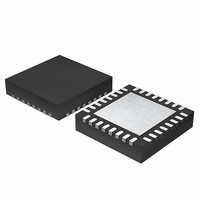EFM32G200F64 Energy Micro, EFM32G200F64 Datasheet - Page 30

EFM32G200F64
Manufacturer Part Number
EFM32G200F64
Description
MCU 32BIT 64KB FLASH 32-QFN
Manufacturer
Energy Micro
Series
Geckor
Datasheets
1.EFM32G200F16.pdf
(63 pages)
2.EFM32G200F16.pdf
(10 pages)
3.EFM32G200F16.pdf
(463 pages)
4.EFM32G200F16.pdf
(136 pages)
Specifications of EFM32G200F64
Core Processor
ARM® Cortex-M3™
Core Size
32-Bit
Speed
32MHz
Connectivity
EBI/EMI, I²C, IrDA, SmartCard, SPI, UART/USART
Peripherals
Brown-out Detect/Reset, DMA, POR, PWM, WDT
Number Of I /o
24
Program Memory Size
64KB (64K x 8)
Program Memory Type
FLASH
Ram Size
16K x 8
Voltage - Supply (vcc/vdd)
1.8 V ~ 3.8 V
Data Converters
A/D 4x12b, D/A 1x12b
Oscillator Type
External
Operating Temperature
-40°C ~ 85°C
Package / Case
32-VQFN Exposed Pad
Processor Series
EFM32G200
Core
ARM Cortex-M3
Data Bus Width
32 bit
Data Ram Size
16 KB
Interface Type
I2C, UART
Maximum Clock Frequency
32 MHz
Number Of Programmable I/os
24
Number Of Timers
2
Operating Supply Voltage
1.8 V to 3.8 V
Maximum Operating Temperature
+ 85 C
Mounting Style
SMD/SMT
Minimum Operating Temperature
- 40 C
Lead Free Status / RoHS Status
Lead free / RoHS Compliant
Eeprom Size
-
Lead Free Status / Rohs Status
Details
Available stocks
Company
Part Number
Manufacturer
Quantity
Price
2.4.4 Lockup
2.5 Power management
2.5.1 Entering sleep mode
2.5.1.1 Wait for interrupt
2.5.1.2 Wait for event
2011-02-04 - d0002_Rev1.00
Table 2.18. Fault status and fault address registers
The processor enters a lockup state if a hard fault occurs when executing the NMI or hard fault handlers.
When the processor is in lockup state it does not execute any instructions. The processor remains in
lockup state until either:
• it is reset
• an NMI occurs.
Note
The Cortex-M3 processor sleep modes reduce power consumption:
• Sleep mode (Energy Mode 1) stops the processor clock
• Deep sleep mode (Energy Mode 2/3) stops the high frequency oscillators and HFPERCLK/
The SLEEPDEEP bit of the SCR selects which sleep mode is used, see Section 4.3.7 (p. 100) . For
more information about the behavior of the sleep modes see the EMU documentation in the reference
manual for the device.
This section describes the mechanisms for entering sleep mode, and the conditions for waking up from
sleep mode.
This section describes the mechanisms software can use to put the processor into sleep mode.
The system can generate spurious wakeup events, for example a debug operation wakes up the
processor. Therefore software must be able to put the processor back into sleep mode after such an
event. A program might have an idle loop to put the processor back to sleep mode.
The wait for interrupt instruction, WFI, causes immediate entry to sleep mode. When the processor
executes a WFI instruction it stops executing instructions and enters sleep mode. See Section 3.10.12 (p.
86) for more information.
The wait for event instruction, WFE, causes entry to sleep mode conditional on the value of an one-bit
event register. When the processor executes a WFE instruction, it checks this register:
Handler
Hard fault
Memory management
fault
Bus fault
Usage fault
HFCORECLK as well as flash memory.
If lockup state occurs from the NMI handler a subsequent NMI does not cause the
processor to leave lockup state.
Status register
name
HFSR
MMFSR
BFSR
UFSR
Address register
name
-
MMFAR
BFAR
-
...the world's most energy friendly microcontrollers
30
Register description
Section 4.3.12 (p. 109)
Section 4.3.11.1 (p. 105)
Section 4.3.13 (p. 110)
Section 4.3.11.2 (p. 107)
Section 4.3.14 (p. 110)
Section 4.3.11.3 (p. 108)
www.energymicro.com


















